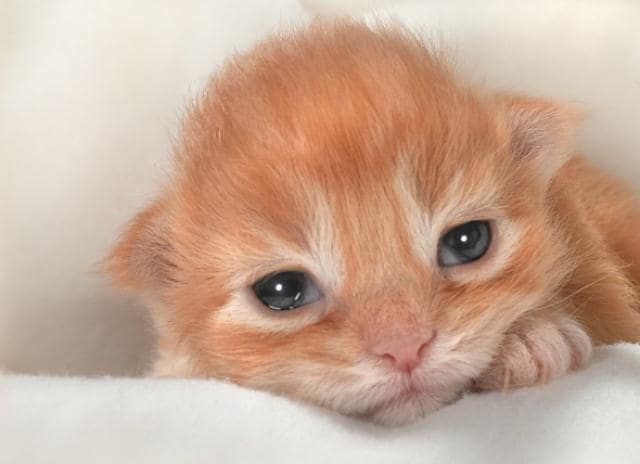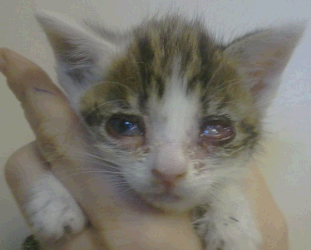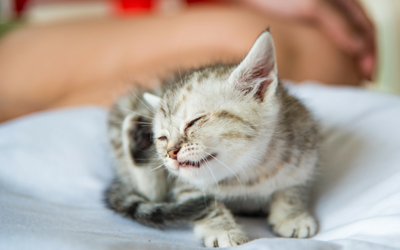Cats are one of the most mysterious creatures to ever roam the planet. Moody and unapologetically sassy, they don’t need a reason to act the way they do. However, they also give the warmest cuddles, and their purring is therapeutic. When it comes to feeling sick and their overall health, cats are also very good at hiding their pain, and so it is easy to miss the signs that something is wrong unless you’re looking. So, you shouldn’t feel guilty if you initially did not notice something is wrong.
However, some ailments can be pretty obvious, and an eye infection is one of those ailments. Just one look at your cat, and you’ll notice that their otherwise bright and clear eyes are looking red, swollen up, and/ or gooey. They may also be exhibiting strange behavior, such as constantly pawing at their face, especially at their eyes. They may also be rubbing their face on surfaces such as your sofa or your carpet. These are all telltale signs of an eye infection and should not be ignored. You should visit your vet if these symptoms continue for more than 24 hours.
Several reasons can cause an eye infection in your feline and are treatable for most of the part. However, if you ignore the signs of eye infection for too long or choose to treat your cat yourself without proper guidance, things can go south. While eye infections don’t kill cats, it does cause extreme discomfort and distress to your feline and if not treated properly and on time, can lead to blindness.
Thus you must be well aware of everything related to your cats, including their eyes.
Causes of eye infections:

A healthy cat will have clear and bright eyes. If there is excessive discharge coming out of your cat’s eye, or if they seem cloudy, or if your cat is showing signs of distress such as squinting or blinking a lot, that means something is wrong.
What causes eye infections in cats? There are several possibilities. These include:
- Upper respiratory infections: If you’ve noticed excessive discharge coming from your cat’s eye, there is a possibility of a virus being the cause. Viruses such as feline calicivirus (which is a contagious respiratory illness), rhinotracheitis ( a herpesvirus), pneumonitis, protozoa, or bacteria can all cause your cat eye problems. The symptoms usually start mild and gradually become worse. A common symptom is when there is a pus-like sticky discharge.
- Pinky eye or conjunctivitis: This is when the pink lining of your cat’s eye becomes inflamed, and as a result, either one or even both eyes look swollen and red. Your cat may begin to seem sensitive to light and will have a thick, clear, or watery mucus discharge. Conjunctivitis coupled with diarrhea, fever, and breathing problems can be indicative of a fatal and infectious feline peritonitis, although this is a rare case.
- Epiphora or tearing/ watery eyes: If your cat is suffering from excessive amounts of tears in their eyes, a possible list of reasons can include blocked tear ducts, viral conjunctivitis, or allergies, to name a few.
- Keratoconjunctivitis sicca or dry eyes: This is when there is a chronic lack of production of tears. This can lead to the cornea becoming inflamed, red eyes, and if it progressively becomes worse, it can cause blindness. Since no tears are being produced in your cat’s eye, instead, there will be a yellow and gooey discharge coming out of their eye.
- Corneal disorders: This is when the cornea, which is the dome-shaped surface that covers the front of the eye, becomes injured, inflamed, or ulcerated. As a result, your cat’s eyes may become cloudy, inflamed, may blink excessively, and may also produce excessive tears.
- Uveitis: This is when the internal parts of your cat’s eye become inflamed. Cancer, trauma, infections, or immune problems usually cause this. This is a symptom rather than a cause.
- Other possible reasons: allergies or a foreign body is lodged in their eye.
Where younger cats are concerned, the more likely causes include viruses or bacteria. The most commonly diagnosed bacteria in younger cats are Mycoplasma and Chlamydia, and the most common viral causes are calicivirus and feline herpesvirus type 1. The reason why these affect younger cats in specific is that they have a much weaker immune system.
As far as older cats are concerned, especially those that come from a stable and loving environment, eye infections can happen as a result of another health problem such as an autoimmune disease, feline immunodeficiency virus, feline leukemia, and eye trauma.
Symptoms to look out for:

The onset of a possible eye infection is easy to detect since the symptoms are obvious. The symptoms include:
- The white part of your cat’s eye has become red.
- The third eyelid has become more prominent and is creating a cover over the inflamed eye.
- There may be discharge coming out of your cat’s eye. This can be yellow, green, or even clear.
- You may notice your cat winking or pawing and rubbing its eyes.
- Your cat may show other symptoms such as nasal discharge or sneezing.
Diagnosing and home treatments:
As beautiful as your cat’s eyes are, they are also very sensitive, and eye-related problems need to be handled with care. As a result, it is always advised that if you notice any of the above-mentioned symptoms, seek medical help without delay.
If your cat has suffered from an eye infection before and you have leftover medicine at home, do not use that on your cat. There are different possibilities for your cat’s eye problem, and different causes have different treatments. Until a professional vet doesn’t examine your cat and give a diagnosis, no medicine should be used. Wrong medicine can lead to severe complications for your cat.
Your vet will examine your cat’s eye and look for signs of an upper respiratory-related infection or possible trauma and will also examine the structure of your cat’s eye. They may even take a swab or scrape the cells from the eye to try to determine what is causing the infection. If they determine that the infection is a symptom rather than a cause, they might suggest blood work and tests determine the root cause.
How are eye infections treated:

The good news is that eye infections can easily be treated. Just as long as you visit the doctor on time and follow their instructions, your cat will make a speedy recovery.
As far as bacterial infections are concerned, they can be treated with antibiotics that are administered either in the form of a topical ointment or in the form of drops. Oral medicines are not usually prescribed for eye infections.
Viral infections are self-limiting for most of the part; however, vets do recommend antibiotics to eliminate the possibility of a viral and bacterial infection occurring simultaneously. More severe cases will require anti-viral medicines.
We cannot stress enough the fact that eye problems usually look the same and can only be diagnosed by a proper evaluation by the vet. Diseases such as glaucoma, anatomic defects, and something as simple as a foreign body entering the eye can also look like an eye infection.
How to take care of your cat’s eyes:

While you can’t diagnose and administer treatment without professional help, there are certain steps that you can take to keep your cat and their eyes healthy.
Make sure that you are up to date with all of their vaccinations. If you have more than one cat at home, make sure that they have enough space to avoid overcrowding. This is especially important since illnesses such as eye infections are contagious.
Also, keep an eye on your cat’s eyes. Look out for cloudiness or redness or sensitivity to light, or unusual discharge. Routinely clean your cat’s eyes as well. To clean their eyes:
- Take a cotton ball and soak it in water. Wipe the discharge by starting from the corner of the eye and make your way outward. Make sure you use fresh cotton for each eye.
- Until and unless prescribed by the doctor, avoid over-the-counter eye medication.
Conclusion:
When it comes to our pet’s health, we feel responsible, especially if we miss the signs. Eye infections are pretty common in cats and are treatable. Unless your cat has a more serious underlying health issue and the infection is a cause of that issue, or unless your cat has contracted a rare infection, eye problems aren’t fatal. However, they do cause extreme discomfort and distress to your cat, which is why you need to make sure you eliminate all the possible causes to avoid them affecting your cat. Also, make sure you are aware of any changes in their behavior. If you do notice something is not right, don’t delay a visit to the vet. The sooner you get medical help, the easier it will be to treat them.
